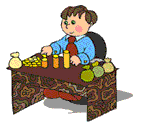CLASSROOM ECONOMY
LESSON PLAN MODEL SYSTEM JOB MANAGEMENT IDEAS WORKSHEETS TEACHING EXAMPLE
TOPIC WORK
SKILLS EDUCATION
SYLLABUS BUILD STRATEGY EXERCISE ACTIVITY PROJECTS TUTORIAL CURRICULUM
ONLINE RESOURCES

| |
 Teach
and learn about creating a mini classroom economy. Teach
and learn about creating a mini classroom economy.
|
| |
|
| |
 |
MONEYINSTRUCTOR-NOMICS:
CLASSROOM ECONOMY
A series of lessons for creating and implementing a classroom economy. Students learn
an introduction to economics by being actively involved in a mini economy, named MoneyInstructor-nomics.
This 10-week unit is compressed into 15 lessons. Each lesson includes background, objectives for the teacher, a detailed, sep-by-step plan, a selection of student activities, questions, journal topics, examples, or templates. The lessons begin with an overview for the teacher, sample parent letter, background, objectives, and class activities. |
 |
|
|




|
|
|
 |
 |


|
CREATING A CLASSROOM ECONOMY
LESSONS AND
WORKSHEETS
|
|
CLASSROOM ECONOMY INTRODUCTION |
|

|
 |
Classroom Economy Introduction
This lesson introduces the economics unit which will take students through the process of introducing currency into a classroom economy, applying for classroom jobs, and opening a business.
|
ATTACHING VALUE TO MONEY |

|
 |
Attaching Value to Money
An introduction to attaching value to money (the MoneyInstructor-Buck). Students learn about barter and using money as an exchange for goods and services.
|
INTRODUCTING CURRENCY |

|
 |
Introducing Currency into the Economy with Part-Time Jobs
A lesson on currency, the economy, and part-time jobs. Students learn to associate part-time jobs with currency that they earn.
|
GETTING A JOB |

|
 |
Getting a Job
Students generate a list of classroom jobs, fill out job applications, and interview for jobs. |
PAYDAYS |

|
 |
Paydays
Students receive payment for their part-time job and begin to keep records of incoming and outgoing funds on an income and expense log.
|
GOODS AND SERVICES |

|
 |
Goods and Services
This lesson will help students distinguish between goods and services.
|
SUPPLY AND DEMAND |

|
 |
Supply and Demand
This lesson focuses on the ways that an increase in supply can effect demand and on the ways that an increase in demand can effect future supply.
|
TAXES |

|
 |
Taxes
Learn about sales tax, federal and state income tax, and the services that are paid for by tax dollars.
|
STARTING YOUR BUSINESS |

|
 |
Starting your Business: Prototypes and Service Demonstrations
Students will start their business by designing prototypes and working on service demonstrations.
|
BUSINESS EXPENSES |

|
 |
Business Expenses
Learn about many of the costs and expenses associated with starting a business. Explore business licenses, locations, patents, taxes, and partnerships.
|
FOCUS GROUPS, MARKET SURVEYS, AND PRICING |

|
 |
Focus Groups, Market Surveys, and Pricing Students will participate in focus groups and will conduct a market survey to determine product or service pricing.
|
PRODUCTION |

|
 |
Production: Assembling a Product, Preparing a Service
Students assemble products and prepare services and will discuss the terms: profit, competition, inventory, specialization, productivity, efficiency, and assembly line.
|
ADVERTISING |

|
 |
Advertising
Students learn about the different forms of advertising and will choose a way to advertise their product or service.
|
CLASS BAZAAR |

|
 |
Class Bazaar 
The bazaar is the big event that students have been working towards. Students will buy and sell their products and services.
|
CLOSING THE ECONOMY |

|
 |
Closing the Economy 
Students figure their total profit from sales and pay a tax on it. Also, they will participate in a white elephant auction.
|
| |
|
|
Back to more
Elementary Economics Lessons
To teach and learn money skills, personal finance, money management, business,
careers, and life skills please go to the Money
Instructor home page.
|
|
|
Lessons appropriate for: 2nd 3rd 4th 5th
6th 7th Graders. Second Grade - Third Grade -
Fourth Grade - Fifth Grade - Sixth Grade - Seventh Grade -
K12 - Special Education - Young People |
|
 |
© 2002-2009 Money Instructor
 |
|
|